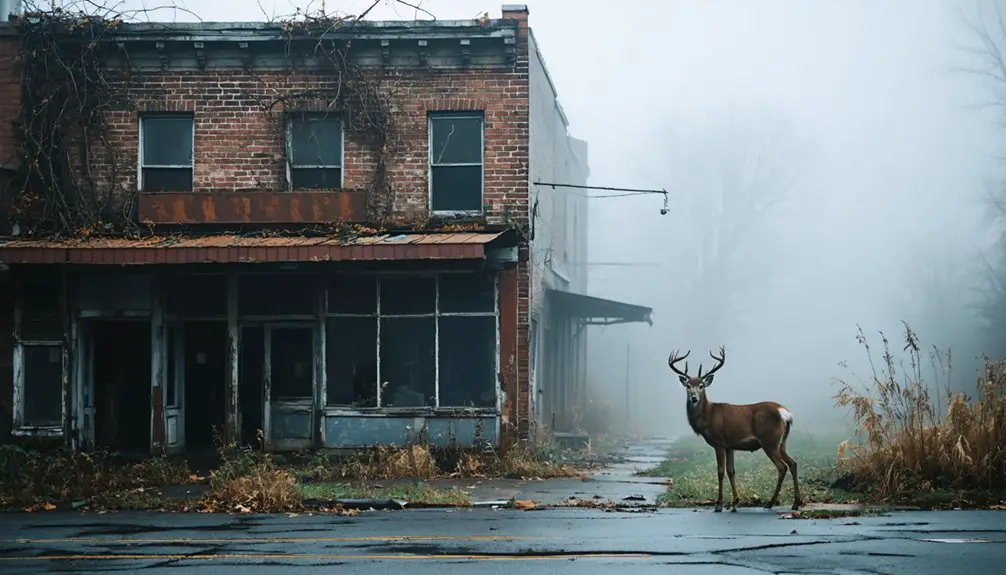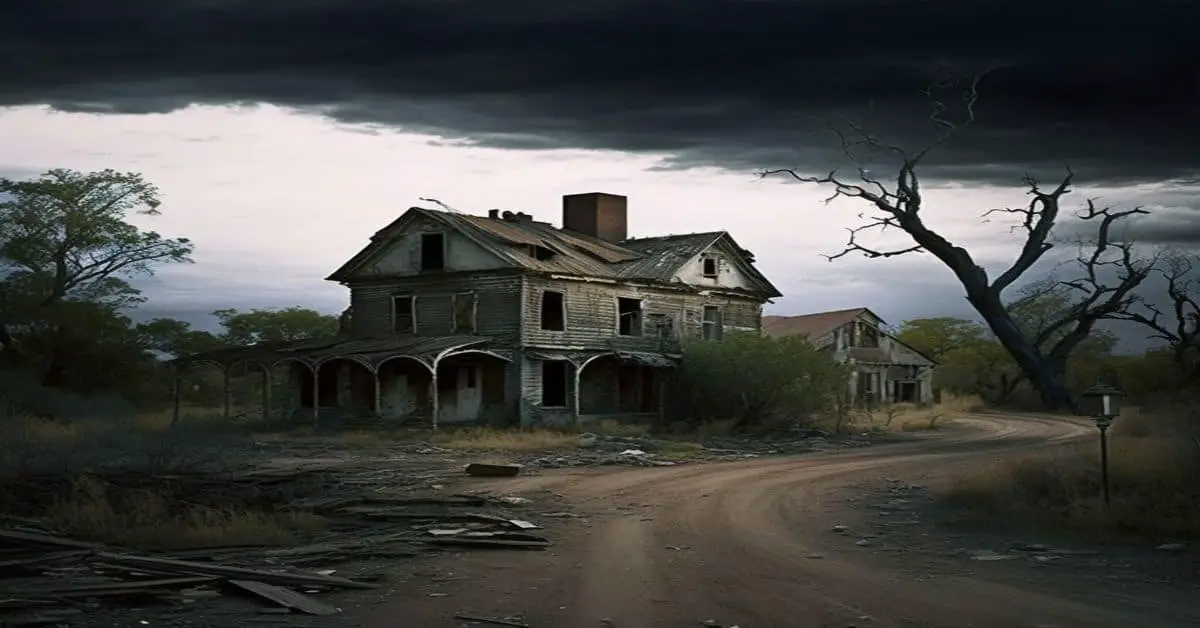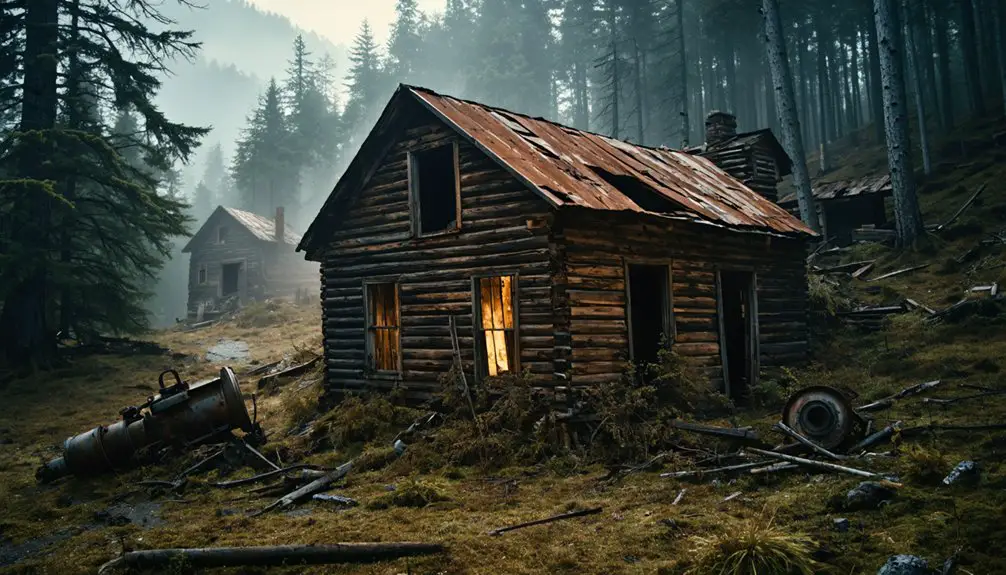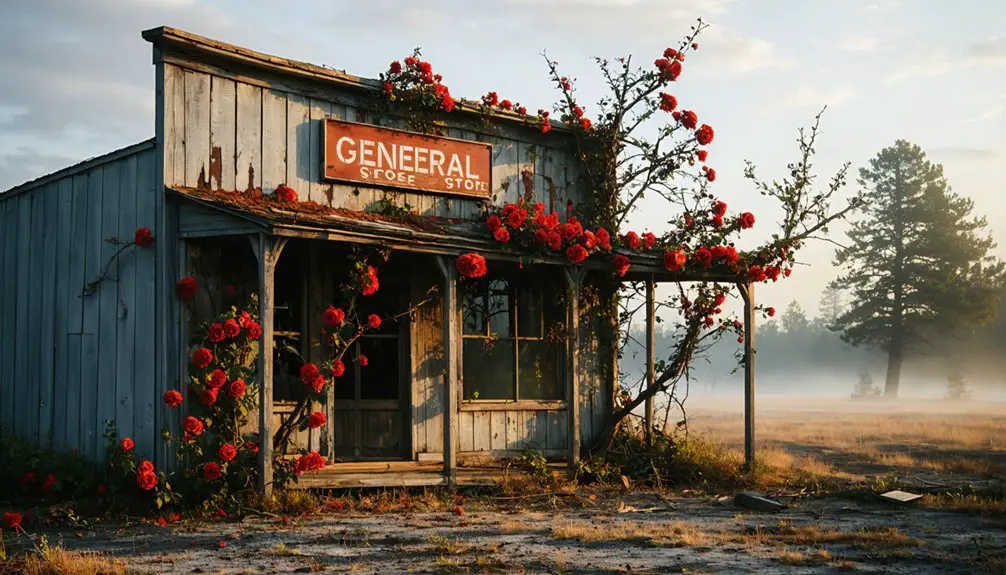You’ll discover Frankville’s haunting remains in Garrett County, Maryland, where this 1856 mountain settlement once bustled with 17 homes and two sawmills. The ghost town’s crumbling foundations tell tales of frontier industry, including its B&O Railroad connection and iron furnace operations. Local legends speak of spectral figures, including Governor Francis Thomas’s ghost walking the tracks where he died in 1876. The site’s supernatural history and deteriorating structures hold deeper mysteries within its overgrown paths.
Key Takeaways
- Frankville emerged as a mountain settlement in 1856 with 17 residences and two sawmills before declining into an abandoned ghost town.
- The town’s deterioration stemmed from limited industrialization and economic shifts away from small rail stops and lumber commerce.
- Notable supernatural reports include ghostly sightings, shadowy figures, and unexplained phenomena throughout the abandoned settlement.
- Former Maryland Governor Francis Thomas met his tragic death near Frankville in 1876, adding historical significance to the location.
- Today, Frankville features deteriorating structures, stone foundations, and a small cemetery dating to 1865 among challenging mountain terrain.
The Rise and Fall of Frankville
While many ghost towns in Maryland emerged from the coal industry’s boom and bust, Frankville’s story began as a modest mountain settlement that showed early promise.
Unlike Maryland’s coal-driven ghost towns, Frankville started as a hopeful mountain community before fading into history.
You’ll find the community dynamics of 1856 reflected in its 17 residences and two sawmills, marking it as a functional frontier outpost. The transportation evolution began with the Frankville Road Company’s incorporation in 1853, later enhanced by a B&O Railroad station that connected this mountainous hamlet to larger markets. Similar to the tragic story at the Mary Surratt House, visitors have reported hearing mysterious whistles and footsteps echoing through the abandoned buildings.
Despite these foundations, Frankville never achieved substantial industrialization. By 1912, though still inhabited, the town’s limited economic base couldn’t sustain growth. Like many locations along the National Road, the town’s history became intertwined with local legends and supernatural tales.
As regional economies shifted away from small rail stops and lumber-based commerce, Frankville’s isolation and lack of economic diversity led to its eventual abandonment.
Legends and Local Lore
Beyond its documented history, Frankville harbors a rich tapestry of supernatural lore that draws paranormal investigators and folklore enthusiasts to its abandoned grounds.
You’ll encounter accounts of ghostly sightings along forgotten pathways, where shadowy figures and young girls in period dress drift through dense woods. Some visitors have reported encountering a terrifying creature with glowing red eyes stalking the outskirts of town.
The town’s cursed legends trace back to an accused witch who allegedly damned the settlement with her final breath, while mysterious handprints on ancient stones seem to validate these claims.
If you venture into Frankville’s forests at night, you might hear whispers of children who vanished without trace, their stories intertwined with tales of occult gatherings and supernatural forces.
Natural landmarks throughout the area bear witness to these phenomena through unexplained cold spots and echoing sounds. Like many of America’s nearly 4,000 ghost towns, Frankville has become a magnet for urban explorers seeking evidence of paranormal activity.
Historical Significance in Garrett County
You’ll find Frankville’s most prominent historical connection to Garrett County through its industrial peak and eventual decline during the late 19th century.
Former Maryland Governor Francis Thomas met his tragic end near Frankville’s B&O railroad tracks in January 1876, cementing the location’s place in state history.
The town’s transformation from an active industrial hub to an abandoned settlement mirrors the broader economic shifts that reshaped western Maryland’s landscape during this period.
During this era, the Underground Railroad station operated by Stephen Willis Friend in the area helped countless enslaved people escape to freedom.
Like many early settlements in the region, Frankville was initially connected to the outside world through indigenous peoples’ trails that later developed into established transportation routes.
Industrial Roots and Decline
The industrial landscape of Garrett County emerged in 1828 with the establishment of an iron furnace along Bear Creek, marking the region’s first organized industry.
You’ll find that this early example of industrial innovation set the stage for Friendsville’s development, though the venture lasted only until 1839.
The region’s resource management evolved as grist milling, woolen manufacturing, and tanning operations spread across settlements like Accident and Selbysport.
When the B&O Railroad arrived mid-century, you could witness the transformation of small communities into bustling commercial centers.
This transportation revolution enabled coal mining and timber harvesting to flourish, particularly in areas like Bloomington.
Yet these industries weren’t sustainable forever – by the early 20th century, resource depletion and changing technologies led to their decline.
The mining town of Vindex thrived in the early 1900s before eventually succumbing to the same economic pressures that affected other industrial settlements.
John Work Garrett played a crucial role in the county’s development through his leadership of the Baltimore and Ohio Railroad.
Francis Thomas Death Legacy
While industrial activity shaped early Garrett County, its political legacy was profoundly marked by Francis Thomas, whose dramatic death near Frankville in 1876 culminated a remarkable career of public service.
You’ll find his influence woven deeply into Maryland’s history through his abolitionist efforts and pivotal role in the state’s 1864 Constitution, which freed 90,000 enslaved people.
Despite political controversies and a scandalous divorce that derailed his higher ambitions, Francis Thomas remained dedicated to progress. Following his early legal career in 1819, he quickly rose to prominence in Maryland politics. Similar to the Rockland mill village established by Dr. Thomas Johnson, Thomas sought to develop local industry and infrastructure.
After serving as U.S. Minister to Peru, he’d chosen Frankville for his retirement, focusing on farming and raising Alpaca sheep.
His tragic death by locomotive while overseeing estate improvements near the town left an indelible mark on Garrett County’s landscape, both politically and historically.
Exploring the Ghost Town Today
If you’re planning to explore Frankville’s remains today, you’ll need to navigate challenging mountain terrain and remote rural roads that provide limited access to the former settlement’s location.
The site offers sparse physical evidence of its past, with most original structures having succumbed to natural deterioration and the reclaiming forces of the surrounding wilderness.
Your exploration should prioritize safety considerations, as the unstable ground conditions and absence of maintained pathways require careful navigation through the mountainous ghost town site.
Physical Remains and Access
Hidden within Garrett County’s mountainous forests, Frankville’s remains await discovery through a network of dirt trails and secondary paths.
You’ll need to navigate carefully, following trail junctions past power lines and turning onto lesser-used routes that lead uphill through thick woods. For urban exploration enthusiasts, the ghost town reveals itself through strategic landmarks – an abandoned church and nearby dam serve as your guideposts.
As you venture deeper, you’ll encounter stone foundations and brick walls embraced by persistent ivy, creating an atmospheric scene straight from history.
The site’s physical remains include roofless structures, a small cemetery with headstones dating to 1865, and scattered vintage automobiles.
You’ll cross ravines and forest crevices, discovering ruins that tell the story of this former Appalachian settlement.
Safety and Preservation Concerns
Because deteriorating structures and hazardous terrain pose significant risks, exploring Frankville demands careful attention to safety protocols.
The site’s mountainous landscape and unmaintained infrastructure create numerous safety risks, while preservation challenges mount from both natural and human factors.
- Watch for unstable ground and crumbling structures, especially after rainfall
- Stay clear of old railroad tracks, remembering Governor Thomas’s tragic accident
- Observe wildlife from a safe distance, as overgrowth conceals potential dangers
- Document but don’t disturb artifacts – removal damages historical integrity
- Check local regulations, as trespassing laws may restrict access
Frankville’s deterioration continues unchecked without active management, and you’ll need to balance your explorer’s spirit with respect for both personal safety and site preservation.
The absence of official safety measures means you’re responsible for your own wellbeing while maneuvering through this historic landscape.
Economic Legacy and Industrial Heritage
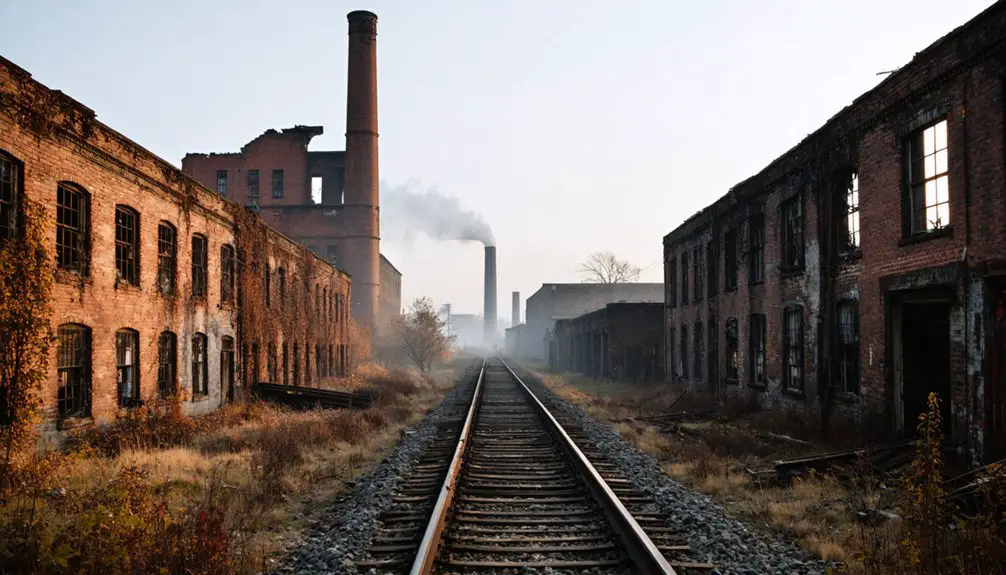
Three distinct industries shaped Frankville’s economic foundation during its peak: timber processing, railroad transportation, and infrastructure development.
You’ll find evidence of economic shifts through the establishment of two sawmills by 1856, which formed the backbone of local industry. The Baltimore and Ohio Railroad station enhanced the town’s industrial sustainability, connecting Frankville’s timber products to broader markets while facilitating regional trade.
The Frankville Road Company’s incorporation in 1853 demonstrates the community’s commitment to infrastructure development.
As you explore records from the mid-19th century, you’ll discover a small but thriving settlement of 17 residences that exemplified Western Maryland’s industrial growth.
Though Frankville ultimately became a ghost town, its industrial heritage greatly influenced Garrett County’s development, setting precedents for resource-based economies in the region.
Haunted Tales and Supernatural Reports
While Frankville’s industrial heritage faded into history, its supernatural legacy continues to captivate researchers and locals alike.
Though industry vanished from Frankville’s streets, tales of the supernatural endure, drawing curious minds seeking paranormal truth.
You’ll find documented reports of phantom sightings dating back to the late 19th century, including encounters with a mysterious figure known to leap over six-foot fences.
The tragic death of former Maryland Governor Francis Thomas by train in 1876 spawned numerous accounts of his spectral figure walking the railroad tracks.
Local cemeteries and abandoned buildings have become focal points of unexplained phenomena.
- Strange lights appear frequently on the old unpaved road
- A feral “Phantom” disturbs residents and leaves peculiar items in homes
- Spectral figures roam among tombstones after dark
- Poltergeist activity affects objects in abandoned structures
- Governor Thomas’s spirit haunts the blind curve where he died
Preservation Efforts and Documentation
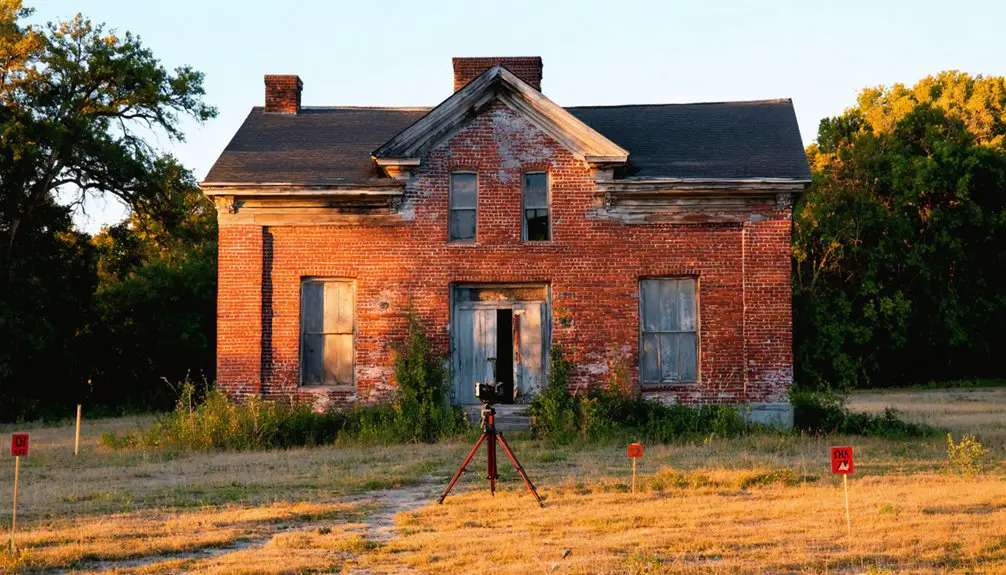
Beyond the spectral tales and mysterious sightings, the physical remnants of Frankville tell their own compelling story through preservation efforts.
You’ll find that while the town lacks formal historic designation, dedicated community involvement keeps its memory alive through Garrett County historical societies and volunteer initiatives.
If you’re researching Frankville’s past, you’ll discover documentation primarily stems from county records, railway data, and postal histories from the 19th century.
Digital enthusiasts maintain online forums sharing historical findings, though preservation challenges persist.
The town’s mountainous location and absence of legal protection have limited large-scale restoration projects.
Yet local historians continue documenting the site through photographs and oral histories, while volunteers clear overgrown paths and mark historical routes, ensuring this ghost town’s legacy endures for future generations to explore.
Frequently Asked Questions
What Transportation Options Exist to Reach Frankville’s Remaining Structures?
Pack proper precautions as you’ll need private transport – there’s no public transport available. You can drive rural roads closest to remnants, then hike rugged trails to reach remaining structures.
Are There Guided Tours or Local Experts Available for Ghost Town Visits?
You won’t find official ghost tours or guided visits here. While local historians document the area’s past, there’s no formal tour program or designated expert leading explorations of the remaining sites.
What Wildlife and Plant Species Now Inhabit the Abandoned Town Site?
You’ll spot white-tailed deer, wild turkeys, and diverse bats amid native oaks and hemlocks. Plant diversity includes goldenrod, mountain laurel, and invasive honeysuckle, while brook trout inhabit nearby streams.
Do Any Former Residents or Their Descendants Still Live Nearby?
You won’t find confirmed records of former residents or local descendants living near the site today, though some families might’ve scattered to nearby towns like Floyd after Frankville’s decline.
What Artifacts Have Been Recovered From the Frankville Site?
While you might expect just historic items, Native American tools, projectile points, shell beads, and bone tools have been found alongside fire-cracked rocks and thousands of lithic artifacts from multiple occupation periods.
References
- https://www.youtube.com/watch?v=r2OfPLbcU3k
- https://chesapeakeghosts.com/witches-of-plain-dealing/
- https://mdhistoricaltrust.wordpress.com/2024/10/31/spooky-sketches-tales-of-marylands-haunted-historic-buildings/
- http://allenbrowne.blogspot.com/2012/03/upper-potomac-ghost-town-in-southwest.html
- https://en.wikipedia.org/wiki/List_of_ghost_towns_in_Maryland
- https://wikihandbk.com/wiki/Английская_Википедия:Frankville
- https://kids.kiddle.co/List_of_ghost_towns_in_Maryland
- https://www.youtube.com/watch?v=xI4nYQycqOw
- https://www.youtube.com/watch?v=UVSnRHmpvM0
- https://ccplonline.org/blogs/adult/truly-scary-maryland-folklore/
